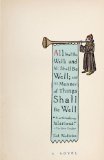Summary | Excerpt | Reading Guide | Reviews | Beyond the Book | Read-Alikes | Genres & Themes | Author Bio

This article relates to All Shall Be Well; And All Shall Be Well; And All Manner of Things Shall Be Well
Hildegard von Bingen
Hildegard von Bingen
(1098-1179), whose writings and music are integral to the novel, was trained by an
anchoress named Jutta and, in the book, is one herself. An anchoress is a female hermit – a woman who,
for religious reasons, voluntary shuts herself off from the world. Although
information on Hildegard confirms that she chose to emulate Jutta throughout her
life, it is not clear that she was an anchoress herself. In fact,
considering her achievements include founding two convents in what is now
Germany it seems unlikely she was. What she most certainly was though is a
woman of deep conviction and multiple talents - a
writer, composer, visionary and mystic. Although not a canonized saint within the
Catholic church,
she is often referred to unofficially as a saint.
More about Hildegard.
Julian of Norwich
The title of the book is taken from the writings of another
anchoress, Julian of Norwich, author of Sixteen Revelations of Divine Love.
Though she is revered by Catholics, as well as some in Protestant denominations, very little is known about her life. There is a
church in Norwich,
England that is dedicated to her life and influence, and one of T.S. Eliot's
poems, "Little Gidding," also quotes this statement of Julian's which Wodicka uses as the title
of his novel.
Domenico Ghirlandaio
A Domenico Ghirlandaio
painting
features prominently in Burt's story: he carries a wallet-sized copy of
the c1485 double portrait with him everywhere. The painting is referred to
as the Portrait of an Elderly Man with His Son in the book, magnifying
its connection to Burt's relationship with his son, Tristan. The original
painting is located in the Louvre, Paris.
The Lemkos
Burt's mother-in-law, Anna Bibko, is an important secondary
character in the book. She faces her own historical and cultural demons as a
descendant of the persecuted Lemko people of eastern Europe. Historically, the
Lemkos occupied the Carpathian mountain region that borders Poland and
Ukraine. Between 1944 and 1947 the region was entirely depopulated by
the the Soviet Union and the land was devastated, in order to deprive the
Ukrainian Insurgent Army, which was fighting against the Polish People's
Army, of support. After 1956, some Lemkos returned home, where they
now share the land with Polish settlers who moved into the area in the
interim; but most of the estimated 1.5 million Lemkos worldwide (including the estimated 60,000 living in Poland) are spread far and
wide, living as isolated minorities, making it challenging to keep their unique culture and language alive.
The most famous Lemkos you're likely to have heard of is Andy Warhol (born
Ondrej Warhola) whose parents emigrated to the USA shortly before he was
born from what is now North-East Slovakia.
More about the Lemkos at
the
Encyclopedia of the Ukraine and Lemko.org,
which includes a 2002 BBC article about the Lemko people's fight for survival.
![]() This "beyond the book article" relates to All Shall Be Well; And All Shall Be Well; And All Manner of Things Shall Be Well. It originally ran in April 2008 and has been updated for the
January 2009 paperback edition.
Go to magazine.
This "beyond the book article" relates to All Shall Be Well; And All Shall Be Well; And All Manner of Things Shall Be Well. It originally ran in April 2008 and has been updated for the
January 2009 paperback edition.
Go to magazine.
Your guide toexceptional books
BookBrowse seeks out and recommends the best in contemporary fiction and nonfiction—books that not only engage and entertain but also deepen our understanding of ourselves and the world around us.